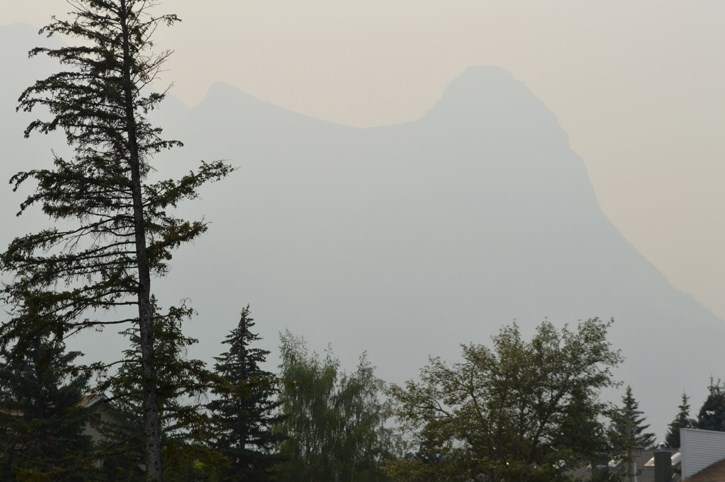The Bow Valley experienced snow and smoke within days – and thick smoke coming from wildfires in the United States is expected to stick around into the weekend.
Snow fell in the mountains on Friday (Aug. 21) as temperatures plunged, but melted the following day. By Sunday, temperatures were warming and by Monday, the Bow Valley was clogged with smoke from major wildfires in Washington, Oregon and Idaho.
“If it wasn’t for the smoke coming from the Pacific Northwest, it would be about six to eight degrees hotter,” said Bill McMurtry, a meteorologist with Environment Canada. “It would be beautiful sunny, hot days in the Bow Valley. There’s not a cloud in the sky. It’s all smoke.”
Alberta Health Services issued an air quality advisory Monday, with the air quality health index reaching very high. Because air quality is expected to be variable, this advisory will remain in effect until further notice.
Alpine Helicopters in Canmore grounded all of its sightseeing tours on Monday and Tuesday, and was expecting that would continue Wednesday and Thursday if the smoke did not clear.
“Any rescue work is still underway,” said Jo-Anne Kobelt, Alpine’s manager of tourism operations.
McMurtry said the wind pattern in the mid and upper level has shifted and is originating from the southwest, carrying smoke from the U.S. fires. It will remain that way until at least the weekend.
“The bad news is the wind is going to remain out of the southwest over an extended period, so that will maintain smoke over southern and central Alberta,” he said.
“As well, at the location where all the forest fires are there’s no precipitation forecast at the same time, so that will mean hot and dry.”
The smoke will be variable.
“It’s not just one big plume,” said McMurtry. “We’re going to experience periods where it’s thick, thick smoke and then it will thin out, and then thicker smoke will move in again.”
Jason Cabaj, Alberta Health Services’ medical officer of health for the region, said he is not sure when the air quality advisory will be lifted. It is at the top end of Alberta’s air quality health index.
“The air has worsened and it’s now at a level of risk considered very high,” he said Tuesday. “We’d like people to pay attention to their symptoms if they notice anything unusual.”
Children and the elderly are more at risk, but with current conditions, even healthy individuals may experience temporary irritation of eyes and throat, and possibly shortness of breath.
Cabaj said people with chronic medical conditions, including respiratory and heart conditions, are also at higher risk, noting smoke may lead them to experience worsening symptoms.
“These individuals should monitor for worsening of symptoms and take the precautions routinely recommended by their physicians if that occurs,” he said.
Meanwhile, McMurtry said the Bow Valley can expect to see above average temperatures into September, noting last week’s snowfall was a little blip. Local ski hills were posting pictures of the snow.
“We try to think it doesn’t happen in August, but it’s quite common to get a spurt of snow briefly in August,” he said. “Whenever it falls at this time of year, it melts very quickly.”
To reduce exposure to the current air conditions, AHS recommends:
Reduce presence of smoke in indoor environments.
Close and lock all outside windows and doors, including attached garage doors.
Turn down furnace thermostats and furnace fans to the minimum setting. Do not attempt to extinguish pilot light.
If you have an air-conditioner, keep the fresh-air intake closed and the filter clean to prevent outdoor smoke from getting inside.
Avoid running fans, such as “whole-house fans” or “fresh air ventilation systems” that bring more smoky outdoor air inside.
Switch all floor registers to closed position.
Close fireplace dampers on wood burning fireplaces.
Do not use wood burning fireplace, wood stoves or other smoke-producing appliances or features, including candles.
If you must drive to another location, keep vehicle windows and vents closed. Run car fans on re-circulate mode to avoid drawing in outdoor air.
Reduce levels of physical activity, as necessary, to decrease the inhalation of airborne pollutants.
Individuals experiencing symptoms can also call Health Link at 811 to speak to a registered nurse.




